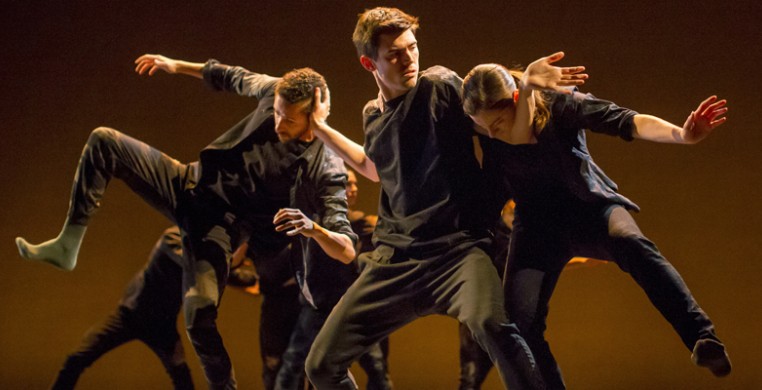Seeing Hubbard Street Dance Chicago’s winter season (Dec. 4-14) at the Museum of Contemporary Art gives us a chance to appreciate the superb artistry of the company’s maturing ensemble up close and personal in a smaller, more intimate venue. While its usual local performance space, the sprawling Harris Theater, gives the dancers a wonderful expansiveness, nuances of musicality, articulation, and physical and emotional responsiveness come into acute focus at close range on the MCA stage. The compression of space, while perhaps slightly diminishing the impact of sweeping group patterns, intensifies other aspects of the dancing.
Under the discerning eye and creative vision of artistic director Glenn Edgerton for the past six years, there’s no mistaking that this company of individually outstanding dancers is knitting itself into a more deeply connected ensemble--more connected to each other and collectively to their material. A palpable esprit de corps radiated throughout the concert, but was especially apparent in the two larger group works on the program, where even occasional slight discrepancies in unison movement were absorbed and adjusted almost instantaneously.
The Princess Grace Awards, established by Prince Rainier and their children in Grace Kelly’s honor, subsidize emerging artists at crucial junctures in their careers. This year, three choreography grants graced HSDC with new works: Kyle Abraham’s reprise of “Counterpoint,” his Chicago Dancing Festival commission (reviewed here in August), Robbin Mineko Williams’ “Waxing Moon,” and Victor Quijada’s “Enter Woven.”
On second viewing of Abraham’s “Counterpoint,” it is striking to note his calculated use of sound, silence, and music to direct focus to the details in his movement. Static white noise accompanies the curvy twisting of bodies intertwining and transforming in fast shape-changers. Quirky shoulder isolations and off-center articulations of a foot or wrist carved through space as if it were a thick, malleable substance. Gelatinous undulations of liquid skeletons echoed in shadow relief across the giant upstage drapes. Lighting designer Dan Scully’s floor rectangles isolated segments of movement and replicated the drapes’ intervals of opening and closing, cutting off and joining together. A central duet, performed on Friday by Jonathan Fredrickson and Jesse Bechard, was a stunning moment of partnering, with the weight of falling and catching an emotional event in counterbalance and human harmony. Johann Johannsson’s “Tu Mi Perderai Mai” infiltrated a heavy drone and driving percussive beat to power sharp elbow accents and intertwining arms. An inspired physical illustration of Brahms’ First Piano Concerto juxtaposed brisés and pas de chats, emboitées and jetés with hip swivels and sexy torso twirls, sometimes mimicking the music, sometimes brazenly challenging it with abstract lines and impulse-driven lunges that somehow brought Brahms to exquisite life on stage. Shifting abruptly to an extended interval of applause and cheering, Kelly Epperheimer’s compelling solo gave poignant testimony to this spit-fire dancer’s continued artistic ascendance. The juxtaposition of contrasting musical idioms, sound, and silence paired with the shifting textures of light and movement to create an entirely engaging choreographic work.
A simple aluminum folding chair is home base for former HSDC dancer Robyn Mineko Williams’ “Waxing Moon,” her fourth work for the company. Talk about great use of a prop! It serves as an intriguing point of both retreat and departure for the trio of dancers, Andrew Murdock, Fredrickson, and Jacqueline Burnett. In addition to integrating the chair into the physical design of the dance, it becomes an extension of the male protagonist’s body and mind as he grapples with relationship and self. Original music composed by Robert F. Haynes and Tony Lazarra, gave an agitated, techno vibe to the sharp focus changes and strong oppositional movement. The male duet was an argument, slicing and cutting through space and across each other’s body planes. The folding chair provided the dancers with dramatic level changes and the emotional intensity of precarious balance. Part two softened to a melodic piano line accompanied by an electronic whine in a male/female pas de deux for Fredrickson and Burnett. Williams’ signature sharp, impulse-driven gestures alternated with silky collapsing moves, slipping through each other's arms. The angst of the techno beat returned and built as solo dancer returned to chair, then segued into a melodic, lyrical final male/female duet for Murdock and Burnett, their hands circumscribing each other’s face. Her strength, his vulnerability, culminate in a beautiful horizontal lift and spin into a happier future.
Programming is as much a part of our overall experience of a dance concert as each individual work presented. “Princess Grace Awards: New Works” is an interesting case in point. Taken individually, each piece displays distinct attributes, but the grouping of the three on the same program, while thematically appropriate, dulled their individual uniqueness. Victor Quijada’s “Enter Woven” has some arresting moments. His large group movement, occurring at intervals throughout the piece, showed strikingly original use of space and multiple unison bodies. The mix of breakdance moves with a perpetual motion machine of congealing and breaking apart held interest initially, but didn’t develop into more than a repetition of itself. The piece went on too long with repetitive material to Jasper Gahunia’s mono-dynamic music, too similar to the techno beat in parts of both previous pieces. Placing “Enter Woven” at the close of this concert cast a drone backwards on the concert as a whole, which required contrast to highlight its unique qualities. By the same token, “Enter Woven” suffered a lack of audience attentiveness in part because of its similarity in dynamics and music to the previous pieces. Even so, the dancing, so versatile in this hybrid piece, was magnificent, and always worth watching.
For tickets,click on “Upcoming Events” at seechicagodance.com.

